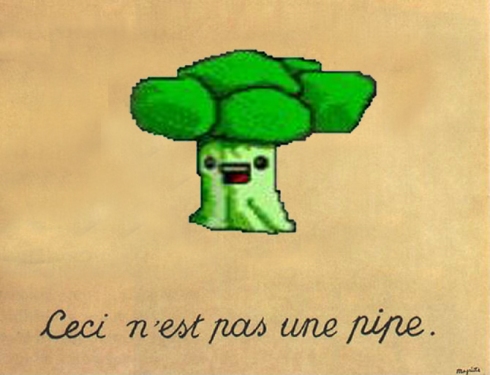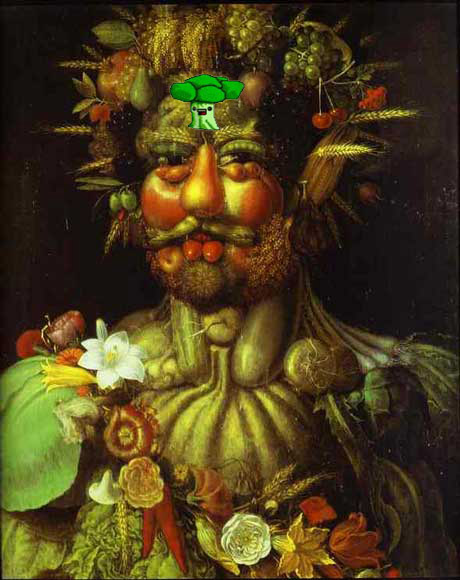One of the great human pastimes is disagreeing about things. You deem broccoli horrible? Well, I think it ROCKS. Broccoli rocks, folks–make no bones about it. It’s an intrinsically great food, possibly even a great humanitarian. And people who say otherwise are simply wrong.
An error in reasoning presents itself here; this argument masquerades as an argument over broccoli, but it pertains to something else entirely. It’s a taste-based squabble in broccoli’s clothing. A difference in primary gustatory area associations hidden in a Trojan broccoli flower. What this argument really pertains to is subjective experience, and as soon as that becomes obvious, there can be no argument. You don’t have to agree to disagree, you instead agree that your perceptions differ from those of your broccoli-hating antagonist.
So, we’ve brought up the “S” word. Through a derisive lens, subjectivity appears the guiding star for people who avoid questioning viewpoints, changing their perspectives, and so on. Defining words becomes an especially muddled process; really staunch subjectivists refuse to do it. Anything can mean anything. You ask what kind of chairs a true subjectivist likes; he says, “Define ‘chair'”. You try, but he questions every word you use to define “chair”, creating a geometrically expanding tree diagram of attempted definitions. You argue that using words to question words is internally inconsistent, but you are denied again. And you never find out what kinds of chairs he likes!
It’s worse when you meander over to fuzzier words: “evil”, “consciousness”, “art”, and “love”, for instance. Words like these get to sit on pedestals so high they are literally hidden from view in the clouds. By extension, it’s hard to discern if there really is meaning sitting up on those pedestals at all, as opposed a big foofaraw. And yet, these words get used constantly and–most importantly–they are understood.
Yeah, sure: people will quarrel over what art “really” is, but at the end of the day, the word exists. It exists in most languages, in fact. Same goes for love, consciousness, and evil. These words are cultural tropes, and they reflect massed perception across generations of human beings. These words, alongside all others, function like any categorical perceptions; they are neural designations that enable an intentional agent to formulate hypotheses about his or her environment. I love, therefore I ____________.
The blank, of course, is where things differ from individual to individual. It represents qualia, or the hypotheses people formulate on the basis of perception. And while there are minute differences from person to person, the fact that the word exists alone indicates that it has anthropological relevance and consistency.
Now we’re hitting the ‘P’ word pretty hard. So what is meant by perception, anyway? To illustrate perception in action, the McGurk Effect serves well. Click that hyperlink and watch the video, would you? Just a slovenly young gentleman saying “Da da, da da, da da” or perhaps “Ga ga, ga ga, ga ga”, right? Now close your eyes and play the video again (these instructions are making me feel like a failed magician, so please be awestruck by the video). Sounds… sheep-like, wouldn’t you say? Perhaps like the stuttered lyrics of The Beach Boys’s “Barbara Ann”? Well, that’s because the audio is “Ba ba, ba ba, ba ba”. Now you can happily watch the reactions of excited Japanese people to the McGurk Effect without spoilers.
There are two interesting facets to the McGurk Effect:
1) Your visual processing stream influences how you perceive sound.
2) Assuming lack of blindness, deafness, feralness, etc., everyone‘s visual processing streams influence how they perceive the sounds used in the McGurk Effect the same way.
In general, brains are pretty much the same. Yeah, they’re plenty complicated. Yeah, no two brains are identical. But they’re built of the same building blocks, with the same receptors, the same transmitters, and the same layouts. γ-Aminobutyric acid inhibits receiving neurons. Purkinje cells populate the cerebellum. Betz cells are found projecting long axons to local circuit neurons in the spinal cord. The posterior superior temporal sulcus preferentially processes human bodily movements. The medial temporal region of the left hemisphere prefers non-human movement. Heschl’s gyrus activates during processing of semantic information. Unpleasant words activate right amygdala and auditory cortex, while pleasant words activate left frontal pole. And for people familiar with broccoli, there’s probably a very special cluster of neurons in the temporal lobe that devotes itself to firing for broccoli. That’s just how things organize themselves. And yeah, brains are plastic, but the mechanisms for that plasticity are the same across different brains, too.
Goodness, that’s a lot of links.
Anyway, the point: perception exists, and it varies how we describe and think about things, but one can be objective about that subjectivity. After all, perception works pretty much the same way in everyone. There does not have to be a screen in between people who perceive things differently. They’re both perceiving, after all. Sure, you can argue for perceiving perception differently, but then we’d just be stuck in a rut, wouldn’t we?
Extending this notion of universal perceptual mechanics to semantic kerfuffles, we come back to the notion of definition. In computer programming, defining is as easy as 1, 2, 3.
1) >>> x=1; y=2; z=3;
2)>>> Wow, turns out it’s easy as just 1, in fact.
3) File “<stdin>” , line 2
Wow, turns out it’s easy as just 1, in fact.
^
SyntaxError: unexpected token ‘out’
>>>
Easy as a nympho on scopolamine, no? Defining art in code, however, is a completely different ballgame. But that’s kind of the point of art, isn’t it? Questioning the very paradigms that conventionally define it? It’s almost like the word has more value when its definition is just out of reach (of course, that itself can be seen as a definition, but that’s a discussion for a separate blog post). But what about something like consciousness? What does that word mean, seriously?
Like art, consciousness gets regular updates and reinterpretations from those investigating it. Like any firmly established word, it has its cultural roots. Just about everyone has a basic sense of what consciousness is. However, as we learn more about what contributes to conscious experience, it becomes valuable to ask more and more exacting questions, questions that enable the building of an experimental paradigm. Questions like: What neural mechanisms give rise to shifting between conscious and unconscious states? Is linguistic confirmation a valid way to assess consciousness? How do attention and sense modalities contribute to awareness? And these inquiries barely scrape the surface of the leviathan that is the meaning of “consciousness”.
Anyway, the point: think about a chair. Take away fragments of that chair. When does it stop being a chair? Neurally, the answer is, “the object in question ceases to be a chair when the object no longer brings to threshold your neural cluster responsible for responding to objects it has learned to discern as chairs”. After all, there are no chairs out in the “real world”. Chair is simply the word we assign to objects perceived as, well, chairs. Now think about the word “is”. What is “is”? A singular third-person verb indicating equivalence? Really? That’s all you’ve got? Sometimes, you can be surprised by words. Sometimes, it’s fun to reduce things to the absence of meaning. Consider it a thought exercise.
Seriously though, broccoli is fantastic. That is the only absolute truth mankind can ever know.






